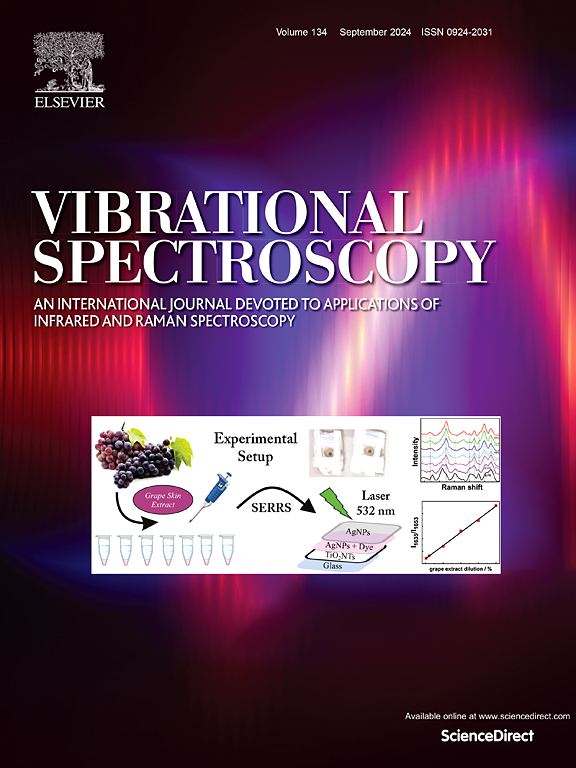Early diagnosis of ulcerative colitis based on urine SERS and multivariate analysis
IF 3.1
3区 化学
Q2 CHEMISTRY, ANALYTICAL
引用次数: 0
Abstract
Ulcerative colitis (UC) is a type of inflammatory bowel disease (IBD), which can be diagnosed by a combination of invasive endoscopy, clinical examination and histopathology. However, Crohn's disease (CD), as another subtype of IBD, exhibits similar clinical and pathological manifestations to UC. This usually leads to delayed diagnosis of UC and increases the possibility of conversion to colorectal cancer. Moreover, it is difficult to distinguish patients with UC from healthy controls (HC) in early diagnosis. Therefore, it is very important to accurately distinguish IBD subtypes and early identification of UC patients and HC in clinical practice. In this work, surface-enhanced Raman spectroscopy (SERS) was used to measure urine samples from 166 IBD patients (including 83 UC and 83 CD) and 83 HC, totaling 249 samples. It shows that there are significant differences in the intensities at several main Raman peaks between UC and CD, as well as between UC and HC. Then, classification models based on principal component analysis (PCA) were constructed for UC/CD and UC/HC to reduce the dimensionality of the dataset, followed by analysis of the reduced-dimension samples using the constructed support vector machine (SVM) models. After the leave-one-out cross-validation (LOOCV), the UC/CD classification model achieved an accuracy of 72.89 %, sensitivity of 67.47 %, and specificity of 78.31 %, while the UC/HC classification model achieved 82.53 %, 90.36 %, and 74.70 % respectively for these metrics. Therefore, this indicates that SERS, based on urine samples combined with PCA and SVM analysis techniques, can effectively identify IBD subtypes and accurately diagnose UC patients from HC patients, greatly facilitating the clinical diagnosis process. The application of this method has great potential to achieve non-invasive early diagnosis of UC, thereby providing more timely and effective treatment strategies for patients.
基于尿SERS和多因素分析的溃疡性结肠炎早期诊断
溃疡性结肠炎(UC)是一种炎症性肠病(IBD),可通过侵入性内窥镜检查、临床检查和组织病理学相结合进行诊断。然而,克罗恩病(CD)作为IBD的另一亚型,其临床和病理表现与UC相似。这通常会导致UC的诊断延迟,并增加转化为结直肠癌的可能性。此外,早期诊断难以区分UC患者和健康对照(HC)。因此,在临床实践中准确区分IBD亚型,早期识别UC患者和HC患者是非常重要的。本研究采用表面增强拉曼光谱(SERS)对166例IBD患者(包括83例UC和83例CD)和83例HC患者的尿液样本进行了测量,共计249份样本。结果表明,UC和CD之间以及UC和HC之间的几个主要拉曼峰的强度存在显著差异。然后分别对UC/CD和UC/HC构建基于主成分分析(PCA)的分类模型,对数据集进行降维处理,并利用构建的支持向量机(SVM)模型对降维后的样本进行分析。经过留一交叉验证(LOOCV), UC/CD分类模型的准确率为72.89 %,灵敏度为67.47 %,特异性为78.31 %,UC/HC分类模型的这些指标分别为82.53 %,90.36 %和74.70 %。因此,这表明基于尿液样本的SERS结合PCA和SVM分析技术,可以有效识别IBD亚型,准确诊断UC患者和HC患者,极大地促进了临床诊断过程。该方法的应用有很大潜力实现UC的无创早期诊断,从而为患者提供更及时有效的治疗策略。
本文章由计算机程序翻译,如有差异,请以英文原文为准。
求助全文
约1分钟内获得全文
求助全文
来源期刊

Vibrational Spectroscopy
化学-分析化学
CiteScore
4.70
自引率
4.00%
发文量
103
审稿时长
52 days
期刊介绍:
Vibrational Spectroscopy provides a vehicle for the publication of original research that focuses on vibrational spectroscopy. This covers infrared, near-infrared and Raman spectroscopies and publishes papers dealing with developments in applications, theory, techniques and instrumentation.
The topics covered by the journal include:
Sampling techniques,
Vibrational spectroscopy coupled with separation techniques,
Instrumentation (Fourier transform, conventional and laser based),
Data manipulation,
Spectra-structure correlation and group frequencies.
The application areas covered include:
Analytical chemistry,
Bio-organic and bio-inorganic chemistry,
Organic chemistry,
Inorganic chemistry,
Catalysis,
Environmental science,
Industrial chemistry,
Materials science,
Physical chemistry,
Polymer science,
Process control,
Specialized problem solving.
 求助内容:
求助内容: 应助结果提醒方式:
应助结果提醒方式:


